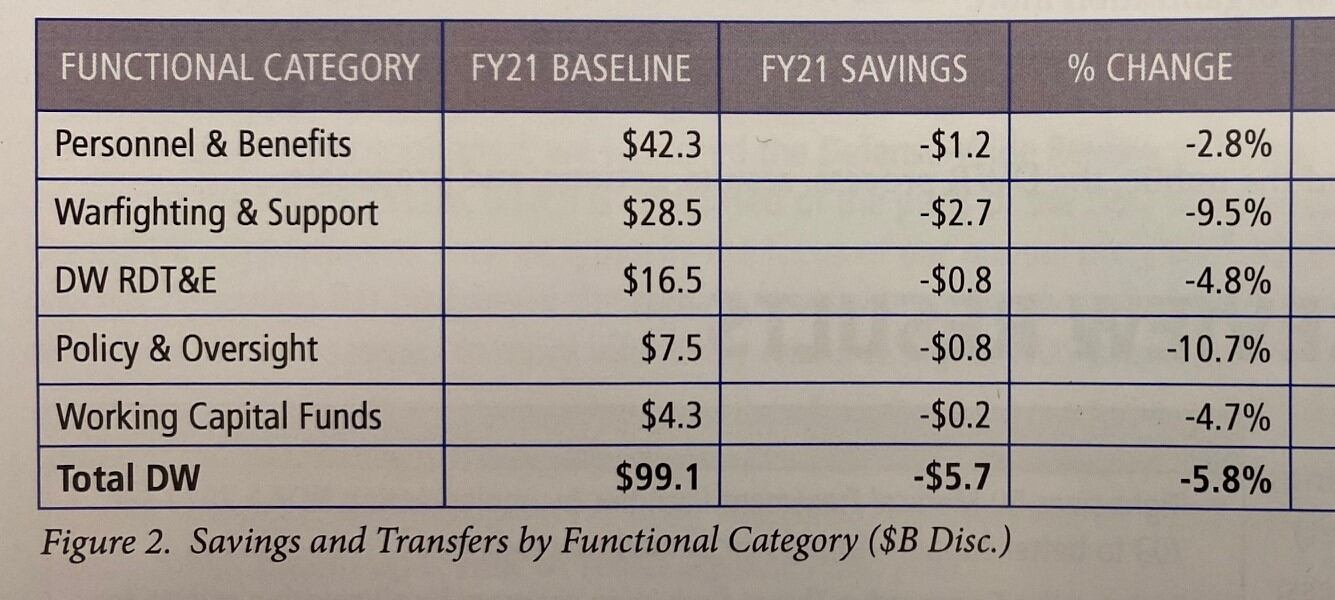WASHINGTON — The Department of Defense has identified $5.7 billion in funding that will be reallocated from current offices towards new priorities such as hypersonic weapons and artificial intelligence, department officials revealed Wednesday.
The money, colloquially referred to as “savings” found through efficiencies, is part of an internal review process of the department’s so-called fourth-estate offices, which include all the defense agencies not associated with either a service or a combatant command.
As part of that reallocation, expect a “significant” change in the Missile Defense Agency’s R&D investments and changes to an agency monitoring nuclear programs around the world, officials told reporters.
The review process was launched by Secretary of Defense Mark Esper after he took office last summer as part of several attempts to focus the department’s energy and dollars on the National Defense Strategy. This effort is largely independent of the review looking at force posture in the combatant commands.
Fourth estate agencies account for roughly $99 billion in funds in the fiscal year 2021 budget, meaning the $5.7 billion in savings represent about 5.8 percent of the overall budget for those offices. Another $2.1 billion was transferred out of the fourth estate and into the services. However, no personnel will be involuntarily terminated from their jobs; any personnel reductions are planned to come from expected retirements.
The funds will be redirected to the following areas:
- Nuclear modernization
- Space priorities, including the establishment of the U.S. Space Force
- Missile defense, with funds going towards a “multi-layered approach to homeland missile defense” and the development of the Next Generation Interceptor
- Hypersonic weapons, with the review providing for a “major increase in this investment” in both FY21 and the following years
- Artificial intelligence, with review funds “significantly” accelerating investment in AI for “maneuver, intelligent business automation and logistics, war fighter health analysis and intelligence data processing"
- 5G communications technologies, with money going towards providing test facilities for 5G prototyping
- Response force readiness, part of Esper’s plan to have forces that can rapidly respond to issues around the globe with a flexible posture
A trio of senior defense officials, speaking on background ahead of Monday’s budget release, briefed reporters on the findings. The officials avoided sharing specific details of where the money was coming from, or how much of the savings are being rolled into specific areas of interest, due to sensitivities with the budget rollout next week. They also declined to say how these savings might reflect over the Future Years Defense Program, a five-year projection included in the department’s budget request.
Missile defense changes
The officials said that there were over 130 decisions made that combined for the total; some saved a hundred thousand dollars, and others saved millions. And the officials gave four large-scale examples of the kind of work that has led to the $5.7 billion.
The first is right-sizing 50 medical treatment facilities by studying the workloads and shrinking or growing the capacity at those locations based on what work is actually needed. Another comes from transferring all remaining storage, supply and distribution missions to the Defense Logistics Agency, something that was a left-over requirement from the 2005 BRAC effort which should lead to savings via economies of scale.

A third example comes from reducing the number of operations run through the Defense Threat Reduction Agency’s Cooperative Threat Reduction (CTR) program, which was stood up to track and monitor weapons of mass destruction. While CTR will continue to monitor potential threats like China, Russia, Iran and North Korea, it was also running a number of programs tracking the work on chemical or nuclear programs from allied nations, one official said — requiring dollars and assets that could be better put to use studying and countering potential threats.
“What we found when we dug into it [is] it had expanded,” the official said. “This has really turned into partnership building, capacity building far beyond the CTR mission. So then we had to ask the question in those areas, is that more impotent than hypersonics? In a lot of those cases we said no, hypersonics is more important than that.”
A fourth example, perhaps the most eye-catching, comes from the Missile Defense Agency, with the official saying a line-by-line review of MDA led to a decision to “divest significant legacy capabilities.”
The review gave MDA an “opportunity to go through and look at some of the investments they are making that are really targeted at things that had either lessened in importance or were declining, and really realign funding to the new threats,” the official said, hinting that a major focus is in changing where MDA dollars are going to R&D as opposed to buying equipment needed now, including on technologies focused on discrimination of threats.
“We could really start to say, what about bringing together some of the things we’ve been doing at the regional level into a new underlay,” the official added. “And we said, the ability to shoot down actual missiles and putting more capability on the ground to shoot down missiles was a higher priority than some of the advanced R&D work which was really taking us from an already good capability to a really exquisite capability.”
Next steps
Esper has already tasked officials to continue the review in FY22, with a plan of finding more savings.
Part of the plan for finding more savings comes from Esper empowering Lisa Hershman, the department’s chief management officer, to take a more active role in shaping the budgets of the fourth estate agencies into something that looks more similar to how the services operate.
RELATED

When a service puts together its budget, it goes through an internal process, where decisions about tradeoffs between offices and programs are fought over before a service secretary makes a final decision and moves the budget up to the secretary of defense level. However, the fourth estate agencies do not currently go through such a process — they drop their budgets at the same time as the services do, without that broad overview of a service secretary.
Going forward, Esper has ordered Hershman to act as, essentially, a service secretary for the fourth estate offices, overseeing their budget development process before presenting a unified budget alongside the services. Doing so should provide better oversight on the process and ensure savings going forward, the officials said.
“We can make the defense wide account balanced, so we’re not getting a bill from MDA and passing it to the services or taking a bill from MDA and saying [others] have to pony up,” the first official said.
However, to find more savings down the road, actual reductions may have to happen. Asked if personnel reductions could come during the FY22 review, all three officials used some version of this phrase: “All options are on the table.” Similarly, a second official said that while no agencies were limited to this round, that could not be ruled out in FY22.
And asked whether there is another $5.7 billion to be found in the remaining parts of the fourth estate, the first official carefully said “I think the secretary thinks it’s repeatable.”
Aaron Mehta was deputy editor and senior Pentagon correspondent for Defense News, covering policy, strategy and acquisition at the highest levels of the Defense Department and its international partners.




